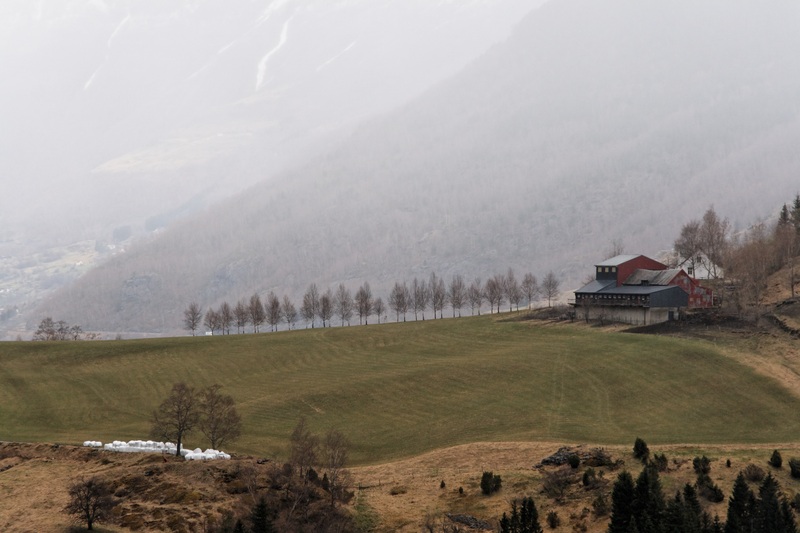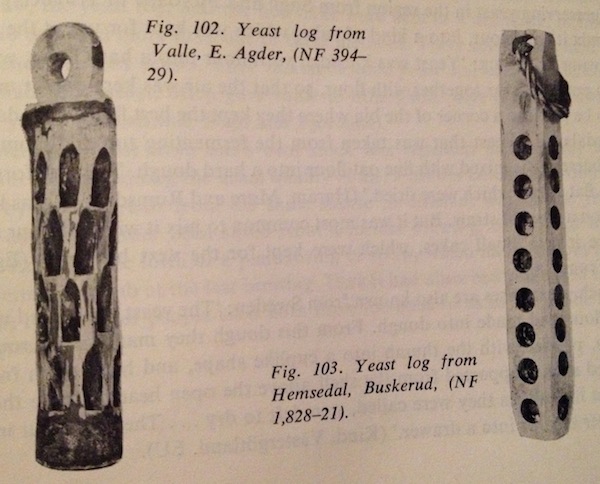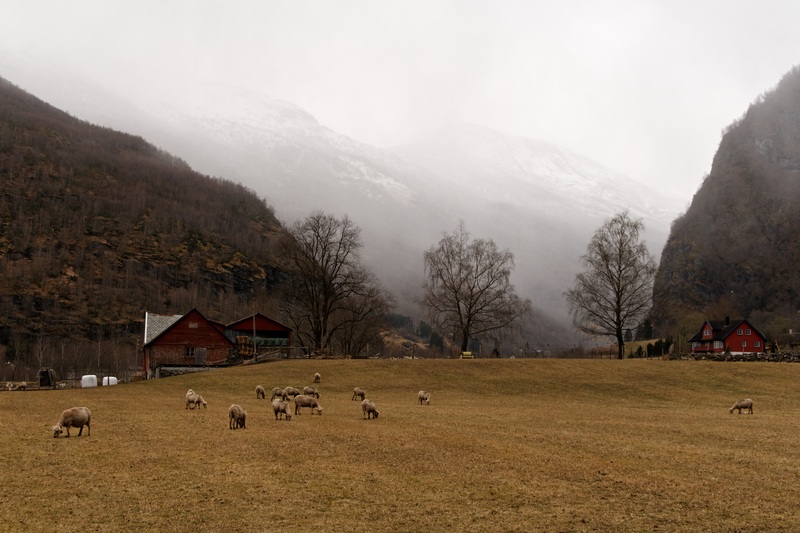Kveik: Norwegian farmhouse yeast

Fretheim farm, Flåm |
If I say "domesticated animals", yeast is perhaps not the first thing that springs to mind, but it was actually one of the first organisms to be domesticated. Evidence of domesticated yeast goes back at least 4000 years. Yeast has been produced commercially since at least the early 19th century, and fairly quickly drove out the private strains that people used to keep at home.
Today, home brewers buy their yeast nearly everywhere. However, in western Norway the traditional yeast lives on in traditional homebrewing. The traditional word for homegrown yeast is "kveik", and not very long ago kveik was found all over the country. Today, very little remains. It exists for certain in Voss, and probably also in Sunnmøre.
Traditionally, bread yeast and beer yeast was the same thing. People would keep yeast from fermentation, and reuse it for baking and later brewing. Many had clear preferences, and would keep only the top yeast or only the bottom yeast, but there seems to be no clear geographic distribution. One farmer would prefer the top, while his neighbour would keep the bottom, and some would do both. Only in Trøndelag does there seem to be a clear preference, in that case for the bottom.
Many different methods for keeping yeast are reported. Bottles were much used, and many stored them in water, such as the well. Some would dry it on straw rings, on linen, or pieces of wood. To make the yeast dry quickly hot ashes were often used. Ashes would absorb water, the heat would contribute to drying, and ash also has the benefit of being sterile.

Kveikstokker (yeast logs) |
A traditional piece of equipment is the "yeast log", a wooden pole with holes drilled in it. Many different designs exist, some of them quite ingenious. The log was lowered into the fermentation vessel to catch yeast, then rolled in flour, dried for a few minutes, then dipped again and the process repeated a few times. Finally it would be hung up to dry. The yeast log in the picture below had the year 1621 carved into the bottom.

Kveikstokk (yeast log) |
Another method was to mix yeast with flour, and knead it into a kind of flat cake. The cake would then be dried and left until it was time to use it again.
Brewers usually preferred their yeast fresh, and if they didn't have any, would borrow from their neighbours. This was common, and taking payment for yeast was unheard of. Some say well dried yeast could last for more than a year, and, if necessary, it could be revived with sugar and water, then dried again. If mold appeared on the yeast it would be thrown away.
Given how hard it is to keep yeast alive and working well, and how it seems to depend on a community of neighbours all helping one another it's not very surprising that kveik has disappeared in most places. But, as I said, it hasn't disappeared everywhere. Michael Jackson found brewers using kveik in Voss in 1995, and there are still people doing it today. It may exist in Sunnmøre, too.
In fact, a sample from one brewer in Voss was submitted to a British yeast bank in 2009. See numbers 3545 to 3552. It was also analyzed at the yeast bank, and that analysis is interesting in several different ways. For one thing, no sign of bacterial infection was found. The sample was in other words pure yeast, so the brewer must have some degree of control over the yeast quality.

Field, Flåm valley |
The researchers wrote that if the yeast had been in use outside a lab for a long time, they would expect it to have diverged genetically into several different closely related strains. And indeed the first analysis found three different strains. A more detailed analysis found another four. All the strains were closely related, with some appearing to be dominant.
DNA sequencing was not done, but the DNA was analyzed with gel electrophoresis and compared with more normal yeast. Analyzed in this way the yeast did not seem "particularly unusual," but the analysis is not nearly as conclusive as full DNA sequencing. No tests have been done on the brewing characteristics of the yeast, so very little is known about that aspect.
One aspect that was unusual was that the yeast produced "moderately well developed pseudomycelia". That is, the yeast cells would cling together in chains. It's not unknown for Saccharomyces to do this, but it is unusual.
Frustratingly, this is where the story ends for now. We know traditional yeast exists. There are indications that it's old and unique, but nothing more is known for certain. Whether it's at all related to the Lithuanian yeast is totally unknown. It's also not clear if anyone is going to do the analysis to find the answers.
Note that it is possible to buy samples of the Norwegian kveik. The prices are fairly stiff, and the procedure around it is not aimed at home brewers, but it is possible to get hold of the yeast if you're sufficiently motivated.

Distant shapes lost in mist, Møre og Romsdal |
Sources:
- Brewing and beer traditions in Norway: The social anthropological background of the brewing industry, Odd Nordland, Universitetsforlaget, 1969. (The pictures are from this book, without permission.)
- Analysis of Norwegian Kveik blend yeast sample and isolation of individual strains for accession into the NCYC, Chris Bond, NCYC, 2009. (The report linked above.)
- Private email from Chris Bond.
Similar posts
Kveik analysis report
One of my goals for the Norwegian farmhouse ale trip was to see if kveik (family yeast) still existed in Norway, and to get samples if possible
Read | 2014-09-26 08:11
Celtic Beer Yeast and Blue Cheese
A recent archaeological find caused much stir and writings in various newspapers, but everyone seems to have missed the most interesting part of the discovery
Read | 2021-11-01 08:59
Was all beer sour before Pasteur?
It's often said that before Pasteur's work on yeast (and Emil Christian Hansen's introduction of the pure-yeast system) all beer was sour
Read | 2014-10-26 18:01
Comments
jason - 2014-09-12 11:03:08
What an interesting article. I stumbled on your blog yesterday and I found it fantastically interesting. The Kveik yeast is particularly interesting because it means that yeast can be propagated indefinitely, contrary to what the common belief is among homebrewers, at least here in the US. I wonder if Kveik could be simulated by combining a number of yeasts to obtain a similar effect. Once a suitable combination was created one could recapture the yeast in the traditional way allowing the subtle shifts to take place over time.
If you ever get over to Colorado let me know, I'd be happy to share a few brews with you, although they will undoubtedly be less exotic than what you have in your backyard.
Cheers Jason
Lars Marius - 2014-09-12 12:52:37
@Jason:
> it means that yeast can be propagated indefinitely, contrary to > what the common belief is among homebrewers
Yes, exactly. Many brewers hold the same belief. It has to be added that keeping a yeast strain going does require having backups. The home brewers solve this by using each other as backup.
If I ever get to Colorado I'll let you know. Meanwhile there's no need to apologize for American beer. It may not be exotic, but it's certainly good.
Matt Spaanem - 2014-09-29 18:37:18
Do you know what sort of wood the kveikstokker were made from? I'm guessing juniper like the boughs used in the strike and sparge water? I was thinking of trying to make one to try drying some of my wild caught indigenous yeasts.
Lars Marius - 2014-09-30 02:43:50
@Matt: there's little discussion of what type of wood is used in the material I've seen so far, so I suspect they don't care that much what type of wood is used. Note that some people thought it was important to leave some of the bark on the log, probably to catch more yeast. You can see it in the figure 102 log above.
Birch has been mentioned as a material. Juniper has not been mentioned, but it's conceivable, although it would be tricky in some places to find branches thick enough. The bottom plate in figure 104 cannot be juniper, as it's much too big and thick.
Oak was not used in Norway (we have very little of it), but it would be interesting to try, since it's thought that Saccharomyces cerevisiae may have originated in symbiosis with oak trees.
Matt Spaanem - 2014-09-30 11:45:41
@Lars: Thanks for your response! I suppose I can make a few from various woods and try them all out. I have access to some oak, as well as juniper and birch. Do you know about how large they typically are? I'm assuming they're only a centimeter or two in diameter based on the photos, but maybe I'm seeing it wrong.
Lars Marius - 2014-09-30 13:27:32
@Matt: I think they were a little bigger than that. One source (NEG 7411) describes a yeast log as 16-21cm long. Another nearby source (NEG 8044) used a log that was triangular in section, 70cm long, sides 10-12cm.
I think about 20cm sounds more "normal" judging by the photos I've seen, like this">http://digitaltmuseum.no/things/kveikstokk/NF/NF.09096-613">this one.
I'd think the diameter would have to be at least 2cm to make the holes a decent size without splitting the log.
Jesse Merrill - 2015-01-01 22:14:30
Hello. Fascinating blog. Thanks so much! I am a sourdough bread baker by profession and have been brewing beer at home using my sourdough culture. It makes wonderful beer, but the complete fermentation takes months. leaving me to suspect that our ancestors had some way of isolating a pure yeast culture. You've just confirmed that for me! What isn't evident is any hypothesis on how they originally isolated the yeast without bacterial contamination. It is commonly held that most sourdough cultures raised from grain or fruit and kept in wheat or rye flour are composed of two to three yeasts and a few lacto-bacillic bacteria. I've been trying to dream up a way to get just the yeast and I have seen no research or discussion on this topic.
I do love the bacterial ferment which gives a deep character like a good lambic, but the secondary (perhaps actually tertiary?) fermentation is just too long for common brewing and if bottled too soon creates a gusher!
So given that farmer-brewers could actually keep a pure yeast strain in primitive conditions, how in the heck did they get that strain in the first place? Have you experimented or heard any folktales on this subject? Thanks a bundle!
Lars Marius - 2015-01-04 05:21:45
@Jesse: Thank you. Yes, there are several pieces missing in the story of yeast, one being where they got it from to begin with. I will be returning to that in later posts. As for the isolation I think that usually happens by itself if you brew several times with the same yeast. The bacteria get outcompeted in a way they don't in bread. Sometimes, the bacteria don't lose out, but my guess is that brewers would prefer yeast from brewers with a pure culture (because the taste would be better), so over time the pure yeast won out.
Getting just the yeast is easy if you have a lab, but I guess you knew that. Without a lab I would try reusing the yeast for several beers, without going via bread. Treat it like the Norwegians treated their kveik, and see what happens.
Jesse Merrill - 2015-01-06 17:01:02
This is such a simple and obvious hypothesis in hindsight, but one that had evaded me before. I had approached my wild yeast experiments from a baker's mindset using the freshest generation of my sourdough culture in every batch of beer. I'm really excited to see what may happen using the dregs of the previous batch. This may be a big breakthrough! Thanks a million!
John - 2015-02-17 04:59:59
I really enjoyed reading this. Thank you. I brew at home in Norway (Buskerud) and I'm now planning to brew using Norwegian Farmhouse Yeast, which is available from bryggselv.no. Apparently, this yeast is from Muri Gård in Stryn and it has been used by brewers for generations. Back to your research, it's a shame these wild yeast populations haven't been characterised sufficiently, given the cultural significance. Unfortunately, without commercial interests funding and support are very limited. It would be a fascinating independent project though, at least to some of us. The molecular ecologist in me imagines there is an informative phylogeographical map waiting to be discovered that, I suspect, reflects our ancient ancestors' migrations across Europe. DNA sequence markers would be required for sure.
Lars Marius - 2015-02-17 08:01:47
@John: It is a shame that these yeast strains haven't been collected more systematically, but I'm now doing it, and am up to four strains (the Muri strain included). I'm working to collect more from Hardanger and Sogn, hopefully also Sunnmøre. I will also try to collect some from Lithuania. So at least the work has begun, and all the yeast strains are available at the NCYC in the UK.
Yes, mapping the DNA would be fascinating. White Labs and University of Leuven are doing a project on that for brewer's yeast in general. I contacted them and asked them to include the kveik yeasts, but they said they already had too much data (would take a year or more to process), so they couldn't do it. But they did order the two Voss kveiks from NCYC the same day, so later on, who knows.
What I've found is that these yeasts are surprisingly different. The Voss ones have one aroma. The Hornindal and Stranda yeasts seem to have another. I haven't brewed with the Muri Gård one yet, so I'm not sure what category it falls in.
Joshua Smith - 2015-05-08 08:10:50
Hei Lars, thanks for all this awesome info. I'm a homebrewer in Stavanger, my wife's from Hardanger. I've been really thinking about trying to make a very typical Norwegian farmhouse ale, using the wlp6788. Now that I've read the history of it, it makes it even more of a cool yeast to use. You said you have some from Hardanger, how did you come by these? Which towns specifically did you find them? I really like the writeup about herbs too, as I think that must've been somewhat essential to farmhouse ales. Have you found any more info about some of the lesser used herbs (other than juniper), or have you started experimenting with any of these?
Lars Marius - 2015-05-08 09:24:56
@Josh: I don't have any yeast from Hardanger yet, unfortunately. I know it exists, but I haven't been able to get hold of any. I'm still trying.
I don't really know much more about the herbs than what I put in the blog post. The brewers I've met and brewed with only use juniper and hops, so I think over the last two centuries probably herbs have not played much of a role. It looks like they may have been more important before that, but unfortunately it's hard to get much information about it.
Jon Bennedsgaard - 2015-05-09 20:22:31
Lars, thanks for all your information on your blog. It's very well written and a joy to read. I have did make a Vossaøl with this Kveik yeast which was shared in the Danish homebrewing society. I'm very pleased with the result - it is an excellent beer. The recipe can be found here: http://haandbryg.dk/cgi-bin/beercalc.cgi?pick=084%20-%20Vossa%F8l&mine=on&sort=date&stylesort=0&numshow=100&namesearch=&brewersearch=
I'm going home to Sandnes to celebrate 17.mai so I would be happy so send you a sample without bothering about the custom. Just drop me an email with your address.
And keep up the good work!
Martin Budden - 2015-11-16 22:43:18
Hi all, I doubt that juniper would work well as a yeast log because juniper is naturally antimicrobial (both antifungal and antibacterial). If you've ever smelled a traditional Scandinavian butter knife made from juniper you'll know that it even smells strongly antimicrobial!
Lars Marius - 2015-11-17 03:23:27
@Martin: It's true that juniper is antimicrobial, although I wonder how you know. As far as I know no research on this has ever been published. If you know of any I would be delighted to have a reference.
Anyway, the juniper would only inhibit yeast that actually touches the wood, and the yeast tends to be layered on fairly thickly. Also, as far as I know, the effect of juniper is only that it causes microbes to form spores and "go to sleep". So I don't think it would actually harm the yeast in any way.
Again, I haven't seen any actual research on this, so I'm not 100% sure.
Keven BH - 2016-01-09 14:36:03
Hi Lars,
I found an article on the antibacterial properties of juniper berries. It's not about the wood, but still it can be a good start.
I assume the wood might act like the berries and inhibit bacterias but not the yeast.
Claudiu Miedar - 2017-08-06 16:56:36
Hi,
Can you mention a place where I can buy kveik yeast? (At The Yeast Bay is out of stock)
Thank you.
Lars Marius Garshol - 2017-08-06 18:23:55
@Claudiu: For you I guess this might be the best place http://www.fermentum-mobile.pl/portfolio-item/fm53-voss-kveik/
Another alternative http://www.omegayeast.com/portfolio/14158-2/
Kenneth Newton - 2020-05-28 19:17:08
Can this yeast be used successfully to ferment moonshine?
Lars Marius Garshol - 2020-06-03 16:10:41
@Kenneth: Yes, it can. In fact, it's already been used successfully in commercial liquor production. The producer said this yeast cut down his production time and also made it taste better.
Maciej Fiedor - 2025-10-16 21:21:50
I tried a Norwegian Farmhouse Ale for the first time recently and reading the ingredients list got me interested in kveik. I really enjoy reading this blog and I'm glad you keep it on-line!